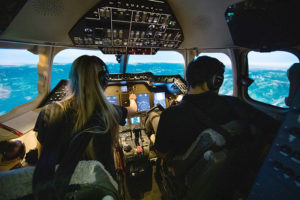The approaching holiday travel season brings concerns of what a pilot shortage could mean for the annual overflowing flight schedules.
That shortage could soon could be alleviated. Purdue (University) Polytechnic Institute has introduced a Degree in 3 program. It is intended to get more flight students properly trained and in the air a year sooner. The move is expected to save participating students $20,000 to $30,000 in tuition and living expenses.
 “There is a global shortage of pilots, and we are part of the solution,” said Manoj Patankar, the Raisbeck Engineering Professor of Aviation Technology and head of the School of Aviation and Transportation Technology (SATT).
“There is a global shortage of pilots, and we are part of the solution,” said Manoj Patankar, the Raisbeck Engineering Professor of Aviation Technology and head of the School of Aviation and Transportation Technology (SATT).
Purdue Polytechnic’s SATT is in the first year of its new Degree in 3 initiative. The initiative started this past summer, allowing select professional flight students to start their degree program en route to completing the traditional four-year program in three years.
The program comes at a good time as worries continue about at shortage of pilots in the aviation industry. Pilot numbers have dropped almost 30 percent during the last 30 years because fewer new pilots are entering the industry, according to numbers from the Federal Aviation Administration.
In addition to getting students into the job market sooner, partnerships between Purdue and the airline industry also allow students to earn specific technical proficiency for Airbus, Boeing and others before they even graduate.
 Sitting on a two-foot concrete pad, the Hawker 900XP is the largest and latest addition to the array of flight simulators in the School of Aviation and Transportation Technology. (Purdue University photo/Brian Powell)
Sitting on a two-foot concrete pad, the Hawker 900XP is the largest and latest addition to the array of flight simulators in the School of Aviation and Transportation Technology. (Purdue University photo/Brian Powell)
“Purdue is certainly leading the pack in terms of being able to graduate students who are job-ready, allowing them to enter the job market sooner,” Patankar said. Trained professional pilots are a particularly important commodity for the airline industry during the holiday season.
Winter holiday flight totals have jumped substantially in the last six years, increasing from 205,727 flights in 2012 to 443,096 flights in 2018. The U.S. Department of Transportation considers the winter holiday a 21-day period beginning on Dec. 14 and ending Jan. 3.
 Purdue’s Hawker 900XP full-flight simulator began operation in September. The in-flight simulator, using the latest technology, is bolstering SATT’s work to put new pilots in the skies. The simulator is qualified at the highest level by the FAA, helping students earn qualifications as a pilot or second-in-command. The opportunity to utilize summertime flying offers other advantages to professional flight students, according to Brian Dillman, associate professor in aviation and transportation technology.
Purdue’s Hawker 900XP full-flight simulator began operation in September. The in-flight simulator, using the latest technology, is bolstering SATT’s work to put new pilots in the skies. The simulator is qualified at the highest level by the FAA, helping students earn qualifications as a pilot or second-in-command. The opportunity to utilize summertime flying offers other advantages to professional flight students, according to Brian Dillman, associate professor in aviation and transportation technology.
“The three-year program leverages better flying weather during Indiana’s summers and improves our aircraft utilization – a win-win solution for all,” he said.
Purdue University
www.purdue.edu





Tell Us What You Think!